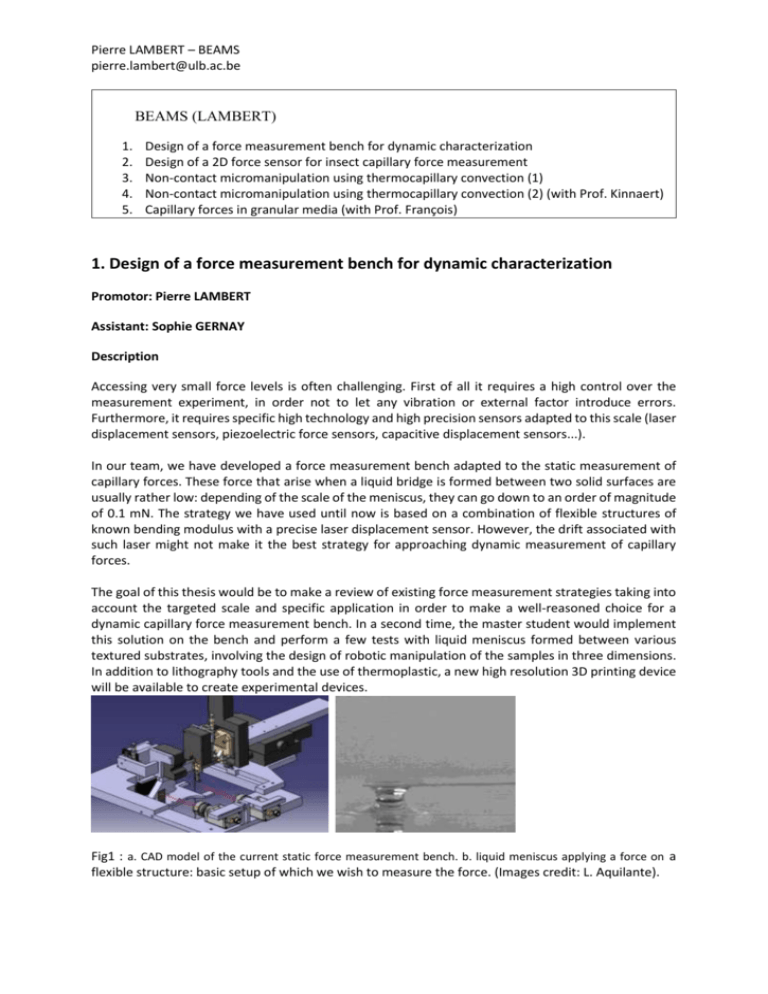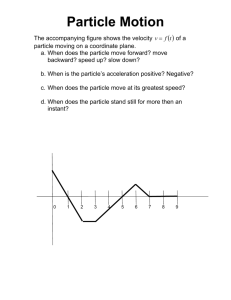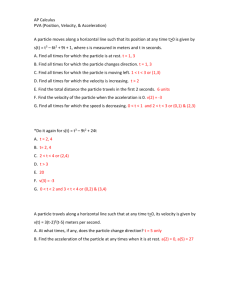LAMBERT_master_thesis_proposals
advertisement

Pierre LAMBERT – BEAMS pierre.lambert@ulb.ac.be BEAMS (LAMBERT) 1. 2. 3. 4. 5. Design of a force measurement bench for dynamic characterization Design of a 2D force sensor for insect capillary force measurement Non-contact micromanipulation using thermocapillary convection (1) Non-contact micromanipulation using thermocapillary convection (2) (with Prof. Kinnaert) Capillary forces in granular media (with Prof. François) 1. Design of a force measurement bench for dynamic characterization Promotor: Pierre LAMBERT Assistant: Sophie GERNAY Description Accessing very small force levels is often challenging. First of all it requires a high control over the measurement experiment, in order not to let any vibration or external factor introduce errors. Furthermore, it requires specific high technology and high precision sensors adapted to this scale (laser displacement sensors, piezoelectric force sensors, capacitive displacement sensors...). In our team, we have developed a force measurement bench adapted to the static measurement of capillary forces. These force that arise when a liquid bridge is formed between two solid surfaces are usually rather low: depending of the scale of the meniscus, they can go down to an order of magnitude of 0.1 mN. The strategy we have used until now is based on a combination of flexible structures of known bending modulus with a precise laser displacement sensor. However, the drift associated with such laser might not make it the best strategy for approaching dynamic measurement of capillary forces. The goal of this thesis would be to make a review of existing force measurement strategies taking into account the targeted scale and specific application in order to make a well-reasoned choice for a dynamic capillary force measurement bench. In a second time, the master student would implement this solution on the bench and perform a few tests with liquid meniscus formed between various textured substrates, involving the design of robotic manipulation of the samples in three dimensions. In addition to lithography tools and the use of thermoplastic, a new high resolution 3D printing device will be available to create experimental devices. 5µm Fig1 : a. CAD model of the current static force measurement bench. b. liquid meniscus applying a force on a flexible structure: basic setup of which we wish to measure the force. (Images credit: L. Aquilante). Pierre LAMBERT – BEAMS pierre.lambert@ulb.ac.be 2. Design of a 2D force sensor for insect capillary force measurement Supervisors: Pierre LAMBERT, Sophie GERNAY Description The ability that some biological species, mainly insects and geckos, have to climb and detach easily from any kind of surface has been intriguing scientists for a long time. However, in order to investigate the mechanisms underlying these characteristics, technological solutions must be found to access the small scales involved. If the physiological characteristics are reached through the use of a microscope, the measure of force levels require the design of a proper tool. This thesis is centred on the design of a sensing device allowing the simultaneous measure of normal (adhesion) and tangential (friction) forces at the scale of an insect leg. Challenges regarding the design step will be the order of magnitude of the considered forces (around 1 mN) and the mandatory decoupling of the two measurement directions. After the choice of a suitable fabrication technique and a calibration step, a few tests will be performed with insects relying on capillary adhesion. a. b. Fig1 : a. Insect relying on capillary adhesion to walk upside-down on a smooth surface. (Image credit : S. Gernay & M. Mayser). b. Example of 2D force measurement setup typically used for insect adhesion investigation. Figure extracted from Division of labour and sex differences between fibrillar, tarsal adhesive pads in beetles: effective elastic modulus and attachment performance, J. M. R. Bullock and W. Federle, Journal of Experimental Biology 212, 1876-1888, 2009 Pierre LAMBERT – BEAMS pierre.lambert@ulb.ac.be 3. Non-contact micromanipulation using thermocapillary convection (1) Promotors: Pierre LAMBERT Assistant: Ronald TERRAZAS-MALLEA, Sam DEHAECK Requested skills: mechanical design, control, microfluidics, experimental skills, matlab, computer vision Context The manipulation of particles in the mesoscale range (100-1000 μm) is a challenge without an optimal solution until now. The transposition of known principles from other scales (larger or smaller) is not appropriate because different physical phenomena are important at this respective scale. Therefore, there is a need to develop new manipulation techniques adapted to this scale, among which we can differentiate between contact (end effector is in contact with the object) and non-contact manipulation techniques (end effector uses a force field to manipulate the object). Regarding the non-contact manipulation techniques, there are different physical principles which can be used to generate force fields: electric fields, electro-magnetic fields, acoustic fields, light refraction (optical tweezers), actuated flows, etc. This work proposes to use laser-induced thermocapillary flow to manipulate particles at the water/air interface. A laser is pointed to a given point in the water interface where it is absorbed and heats the surface generating a thermal gradient which also generates a surface tension gradient which drives the flow movement. Figure 1 Experimental Setup used before Results so far are very promising. Simulations show that flows as fast as 10 mm/s can be obtained. Experimental results show velocities up to 5 mm/s moving a 500 μm diameter spherical steel particle. These results are in pair to other methods for particle manipulation like magnetic manipulation or dielectrophoresis. Figure 2 Particle manipulation sequence keeping the distance particle-laser beam constant at 1 mm. The particle is at the water/air interface moving at the some initial speed Vp_ini. At t0 the laser beam is pointed next to particle, and then it starts accelerating. The new position of the particle is detected, and so the laser spot moves accordingly. Pierre LAMBERT – BEAMS pierre.lambert@ulb.ac.be Figure 3 Filtered particle velocity results when the distance particle-laser beam is constant with a value of 1 mm. Job description The main problem that this proposal faces is the complexity of the physical phenomena involved: fluid dynamics, heat transfer, laser optics and interfacial phenomena which make the system very challenging to analyze. Many parameters can play a role in the performance and have to be analyzed in order to propose a fully repeatable and automatic setup in the future. Figure 4 Particle velocity results when the distance particle-laser beam is constant with a value of 1 mm. Different colors mean different water samples. The objective of this master thesis would be to analyze the main phenomena that cause the poor repeatability of the results (Fig. 4). Although there are many possibilities, currently the ones of interest are: - Contact angle hysteresis: The position of the particle at the interface depends on the contact angle of the particle surface with the water. The already existing analytical models define this problem as a 2DOF problem where either the surface tension force angle α (which depends on the contact angle θ) or the sink distance z have to be fixed. Figure 5 Force equilibrium representation of a cylindrical particle Pierre LAMBERT – BEAMS pierre.lambert@ulb.ac.be The student will have to test this by measuring the distance the particle sinks z experimentally using the interferometry and comparing the result against the analytical model. If the sink distance is different each time, then this means it is actually a 2 DOF of problem and a way to fix 1 DOF will have to be proposed by the student. - Surface properties affecting the contact angle: the contact angle determines how deep the particle will sink. However there are many things that affect this parameter: surface contamination (particle not being clean), manufacturing process, etc., and the variability range can be between +/- 10° which may have a considerable effect in the results. The idea would be to study how feasible is to use coatings of Carbon nanotube-reinforced siloxane to standardize the contact angle no matter which particle is meant to be used. The distance the particle sinks z will be measured using interferometry and compared against the analytical model. On both cases the student will have to perform tests like the one showed in Fig 2, to analyze which is the effect on the particle velocity. A new setup will be implemented in the ULB and so the student will also have to develop the software to handle the actuator (piezo mirror). The particle detection algorithm is already implemented. Pierre LAMBERT – BEAMS pierre.lambert@ulb.ac.be 4. Non-contact micromanipulation using thermocapillary convection (2) Promotors: Pierre LAMBERT, Michel Kinnaert Assistant: Ronald TERRAZAS-MALLEA, Laurent CATOIRE Requested skills: mechanical design, control, microfluidics, experimental skills, matlab, computer vision Context The manipulation of particles in the mesoscale range (100-1000 μm) is a challenge without an optimal solution until now. The transposition of known principles from other scales (larger or smaller) is not appropriate because different physical phenomena are important at this respective scale. Therefore, there is a need to develop new manipulation techniques adapted to this scale, among which we can differentiate between contact (end effector is in contact with the object) and non-contact manipulation techniques (end effector uses a force field to manipulate the object). Regarding the non-contact manipulation techniques, there are different physical principles which can be used to generate force fields: electric fields, electro-magnetic fields, acoustic fields, light refraction (optical tweezers), actuated flows, etc. This work proposes to use laser-induced thermocapillary flow to manipulate particles at the water/air interface. A laser is pointed to a given point in the water interface where it is absorbed and heats the surface generating a thermal gradient which also generates a surface tension gradient which drives the flow movement. Figure 6 Experimental Setup used before Results so far are very promising. Simulations show that flows as fast as 10 mm/s can be obtained. Experimental results show velocities up to 5 mm/s moving a 500 μm diameter spherical steel particle. These results are very promising and are in pair to other methods for particle manipulation like magnetic manipulation or dielectrophoresis. Figure 7 Particle manipulation sequence keeping the distance particle-laser beam constant at 1 mm. The particle is at the water/air interface moving at the some initial speed Vp_ini. At t0 the laser beam is pointed next to particle, and then it starts accelerating. The new position of the particle is detected, and so the laser spot moves accordingly. Pierre LAMBERT – BEAMS pierre.lambert@ulb.ac.be Figure 8 Filtered particle velocity results when the distance particle-laser beam is constant with a value of 1 mm. Job description One of the problems of the current proposal is the repulsive nature of the driving force, and therefore it is more complicated to attain a steady final position. Added to this, there is also the problem of the surface contamination (small particles lying in the water/air interface) which change the surface tension, which bring some significant problems. Because the surface tension is irregular in the interface, the flow velocity will be irregular nearby this “contaminated regions” which introduces noise to the system which has to be compensated by the controller. The particle movement direction is affected, and it becomes more difficult to predict it. Without the surface contamination, it would be expected that the particle would move in the direction of the vector connecting the center of the particle with the center of the laser beam (Fig. 4), however if the surface is contaminated, low surface tension areas exists which disturbs the flow velocity towards certain regions, therefore the direction becomes harder to predict. Figure 9 Particle movement representation: a) Without surface contamination: the direction and velocity are predictable. b) With surface contamination: both the velocity and the direction become unpredictable. Designing a controller that could compensate for both disturbances may be very challenging and so it would be good to only have one of these problems or none of them. Therefore we propose to use the actuator (piezo mirror for laser beam orientation) in order to reduce or get rid of those problems. So idea would be to “draw” shapes that would make the particle movement direction predictable even with the problem of the surface tension contamination. Currently we have two shapes in mind: a ring or a half circle (hook). A ring would trap the particle inside it creating flows that trap the particle in the center of the ring. So in order to move the particle, the position of the center of the ring should be controlled. Although this idea would make the control much easier it has the disadvantage that the particle movement velocity would be seriously reduced because the thermal gradient around would be lower. Pierre LAMBERT – BEAMS pierre.lambert@ulb.ac.be The semi-circle (hook) somehow addresses this problem. By not heating the entire area around the particle, a larger temperature gradient would exist between the current particle position and the next one. However because of this opened area, the direction may not be fully predictable. Figure 10 Laser shapes ideas: a) Ring b) Semi-circle The objective of this master thesis is to implement both ideas and test their performance both in velocity and variability of the particle movement direction. The student would use the experimental setup to perform experiments and gather data that would allow him to characterize the dynamic response of the system with each of the three proposed shapes: dot, ring, semi-circle. Finally the student would determine which are the advantages and disadvantages of each one of the proposals. A new setup will be implemented in the ULB so the student will have to develop a program to handle the actuator (piezo-mirror) in order to implement the control strategies. The particle detection algorithm is already implemented. Pierre LAMBERT – BEAMS pierre.lambert@ulb.ac.be 5. Capillary forces in granular media Promotors: Pierre LAMBERT, Bertrand FRANCOIS Targeted students The topic in geomechanics primarily target students from this field. However, the simulation and modelling work make it particularly well suited for any student interested by multiphysics modelling (physics, mechanics). The experimental set up to be developed and used to measure capillary forces will require interest from the student in practical and experimental aspects Context Capillary forces are known to play a major role in the stability of granular media. In [Gabrieli2011], adapted from [Newitt1958]. The most studied capillary forces regime is the so-called pendular regime (smallest volumes of liquid), in which pairs of grains are connected by a liquid meniscus. This regime has been extensively described, and modelled in DEM simulation of granular soils. Proposed work More on the cutting edge of the current development, the funicular regime is attracting more and more attention. This regime is more representative of actual soils, because the very small amount of liquid necessary to the pendular regime is not very realistic. It has however been studied first because of its axisymmetry which makes it possible to simulate easily. Funicular regimes are therefore more challenging, and require: - - An exact digital model which can be developed with the Surface Evolver software An analytical but unexact model of the capillary force, to be embedded in DEM simulations (exact digital models are expected to be too much time-consuming with respect to the huge number of interactions between grains) An experimental validation of both models, similar to what has been done for pendular regimes [lambert2007]. Pierre LAMBERT – BEAMS pierre.lambert@ulb.ac.be Environment This proposal is built on the expertises in geomechanics and surface tension effects, developed respectuively by Prof. B. François and Prof. P. Lambert. They are collaborating in this field in a joint research project on capillary effects in granular media, funded by the FNRS. International collaborations include Prof. F. Gabrieli in Padova (Italy), who can host any student interested by an internship in this field, prior to his/her master thesis. References [Gabrieli2011] Int. J. Numer. Anal. Meth. Geomech. 2012; 36:918–943 [lambert2007] Capillary forces in microassembly, Springer, 2007 [Newitt1958] Newitt DM, Conway-Jones JM. A contribution to the theory and practice of granulation. Transactions of the American Institute of Chemical Engineers 1958; 36:422–442.







